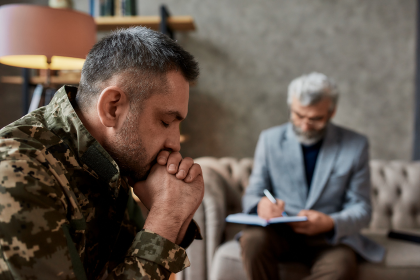Post Traumatic Stress Disorder, or PTSD, affects around 13 million Americans (5% of the population) each year. PTSD can develop after witnessing or experiencing a traumatic event or a prolonged traumatic experience. These harmful events include various accidents, abuse, violence, and more. In this blog, we will go over signs and symptoms, PTSD in the military, treatments, and ways to make treatment more affordable.
For those with PTSD, the symptoms can cause significant distress and disruption to daily life. Each individual experiences different symptoms with varying degrees of severity. Common signs and symptoms include (but are not limited to) the following:
Re-experiencing symptoms means experiencing memories of past traumatic scenes. This includes nightmares, frightening thoughts, flashbacks, being triggered by anything associated with the event, and distress when you’re reminded of the event.
Though PTSD is a mental disorder, the stress it causes can culminate into physical symptoms. These symptoms include muscle tension, headaches, stomachaches, cardiovascular problems, and more.
A common sign and effect of PTSD is resorting to drugs and/or alcohol to try and suppress their psychological stress and other ailments. This could, unfortunately, turn into addiction.
The feelings associated with depression can greatly affect one’s day-to-day life. Examples include no longer being interested in building/maintaining relationships, inability to have fun, feeling isolated from loved ones, uninterested in hobbies, and struggling to stay focused.
The most serious symptom of PTSD is suicidal thoughts. If these thoughts are clouding your mind, then you must seek professional help immediately.
Men and women in the military prepare themselves for the risk of physical injuries but often aren't as prepared for invisible mental injuries as well. PTSD is common for military veterans to develop. Studies even show that veterans who were deployed are three times more likely to develop PTSD compared to those who were not. Some factors that contribute to PTSD are combat situations, military occupations/specialties, or sexual harassment.
If you or someone you know is experiencing PTSD, there are many resources available for immediate help. Call 1-800-273-8255, text 838255, or connect with a crisis responder online. These resources are free and available to all service members, veterans, and their families and friends.
If you believe you are experiencing PTSD, seeing a mental health professional is the first step. There, the professional may suggest treatment. PTSD treatments include trauma-focused psychotherapy and medication such as the following:
Non-medical methods that could help with PTSD include the following:
Both TRICARE and CHAMPVA cover mental health services, including PTSD treatment for members and beneficiaries. To receive treatment, the patient first must visit their primary care provider to discuss symptoms, etc. Depending on which plan you have, the coverage for PTSD treatments varies. Luckily, there are options to help reduce costs.
When the only thing you should focus on is treatment, GEA’s supplemental plans are here. By adding a supplemental plan to your current coverage, the stress of medical bills can be relieved. Whether you have a TRICARE plan or a CHAMPVA plan, our supplemental plans can help cover medical costs your primary plan doesn’t. There shouldn’t be anything getting in the way of you and your health. Don’t let medical costs be a reason. For more information, visit our website.

